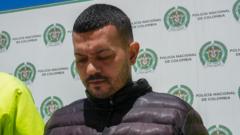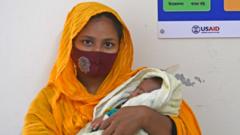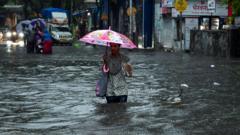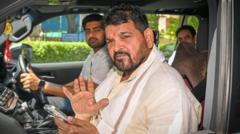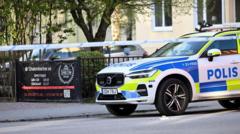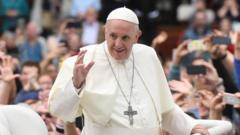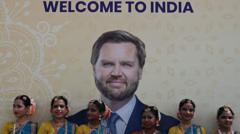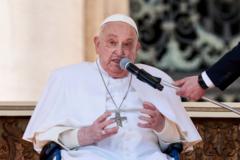In a life-altering surgical operation, doctors in Delhi, India, removed a parasitic twin from a 17-year-old boy, a rare condition that affects less than one in 100,000 births. The boy's underdeveloped twin was physically integrated into his abdomen and had fully formed limbs and other body parts, weighing around 15 kg. This intricate two-hour surgery was led by Dr. Asuri Krishna, who explained that they faced unusual challenges due to the teenager's age and the limited medical documentation on such cases. The surgeons undertook a meticulous separation of shared blood vessels and tissues, all while ensuring the patient remained stable. Following the surgery, the teenager expressed relief and newfound hope for an active future, having previously been hindered by his condition.
A Remarkable Surgery: Indian Teen Freed from 'Parasitic' Twin
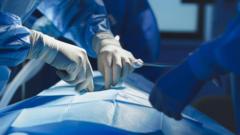
A Remarkable Surgery: Indian Teen Freed from 'Parasitic' Twin
In a groundbreaking procedure, doctors in Delhi successfully removed a 17-year-old boy's parasitic twin, allowing him to begin a new chapter in life.
Doctors in the Indian capital, Delhi, have successfully executed a pioneering surgery on a 17-year-old boy to excise a "parasitic" twin that had been attached to his abdomen. The surgery is noteworthy due to the rarity of parasitic twins, which occur in fewer than one out of 100,000 births. These twins are underdeveloped conjoined twins that are entirely reliant on the host twin for survival.
In this particular case, the young patient had a fully developed extra set of limbs and a pelvis—sustained by an artery from his chest—protruding from his abdomen. The surgical procedure, carried out at the All India Institute of Medical Sciences (AIIMS) in Delhi, lasted approximately two hours. Dr. Asuri Krishna, the lead surgeon, noted the unique difficulties presented by the teenager's age; with only about 40 to 50 known cases of parasitic twins documented globally, they were forced to rely largely on their expertise and intuition.
Parasitic twins typically develop when one fetus fails to fully separate from its sibling during gestation. In this situation, the teenager had two complete legs, buttocks, and external genitalia, which were all contributing to his unique health challenges. Remarkably, the parasitic limbs were responsive to stimuli like pain and temperature.
The surgical team began by mapping out the interconnectedness between the host and the parasitic twin. Diagnostic scans revealed that the parasitic twin was linked to the teenager's breastbone and received blood flow through a vessel in his chest, although it lacked connection to vital organs such as the liver or kidneys. The operation was executed in stages—first focusing on the removal of the parasitic twin and then the extraction of a cystic mass found in the teen's abdomen.
A diverse team, which included radiologists, anaesthetists, and plastic surgeons, carried out the operation in a time-efficient manner, while being mindful of avoiding damage to the host's organs. During the procedure, the teenager experienced a critical drop in blood pressure as a significant portion of his blood was routed to the parasitic twin. Fortunately, the medical team was well-prepared and quickly stabilized his condition.
The young man was able to return home just four days after the surgery, reporting no post-operative complications. Before the procedure, he had faced social isolation and mental distress due to his unusual appearance, which had led him to drop out of school at the eighth grade. Now, energized by his recovery, the teenager expressed his joy with the potential of a new life: “I hope to study and get a job. A new world has opened up to me," he shared with the Indian Express newspaper.
The success of this surgery presents hope and a profound change for the young boy, ushering in a future filled with possibilities.
In this particular case, the young patient had a fully developed extra set of limbs and a pelvis—sustained by an artery from his chest—protruding from his abdomen. The surgical procedure, carried out at the All India Institute of Medical Sciences (AIIMS) in Delhi, lasted approximately two hours. Dr. Asuri Krishna, the lead surgeon, noted the unique difficulties presented by the teenager's age; with only about 40 to 50 known cases of parasitic twins documented globally, they were forced to rely largely on their expertise and intuition.
Parasitic twins typically develop when one fetus fails to fully separate from its sibling during gestation. In this situation, the teenager had two complete legs, buttocks, and external genitalia, which were all contributing to his unique health challenges. Remarkably, the parasitic limbs were responsive to stimuli like pain and temperature.
The surgical team began by mapping out the interconnectedness between the host and the parasitic twin. Diagnostic scans revealed that the parasitic twin was linked to the teenager's breastbone and received blood flow through a vessel in his chest, although it lacked connection to vital organs such as the liver or kidneys. The operation was executed in stages—first focusing on the removal of the parasitic twin and then the extraction of a cystic mass found in the teen's abdomen.
A diverse team, which included radiologists, anaesthetists, and plastic surgeons, carried out the operation in a time-efficient manner, while being mindful of avoiding damage to the host's organs. During the procedure, the teenager experienced a critical drop in blood pressure as a significant portion of his blood was routed to the parasitic twin. Fortunately, the medical team was well-prepared and quickly stabilized his condition.
The young man was able to return home just four days after the surgery, reporting no post-operative complications. Before the procedure, he had faced social isolation and mental distress due to his unusual appearance, which had led him to drop out of school at the eighth grade. Now, energized by his recovery, the teenager expressed his joy with the potential of a new life: “I hope to study and get a job. A new world has opened up to me," he shared with the Indian Express newspaper.
The success of this surgery presents hope and a profound change for the young boy, ushering in a future filled with possibilities.



